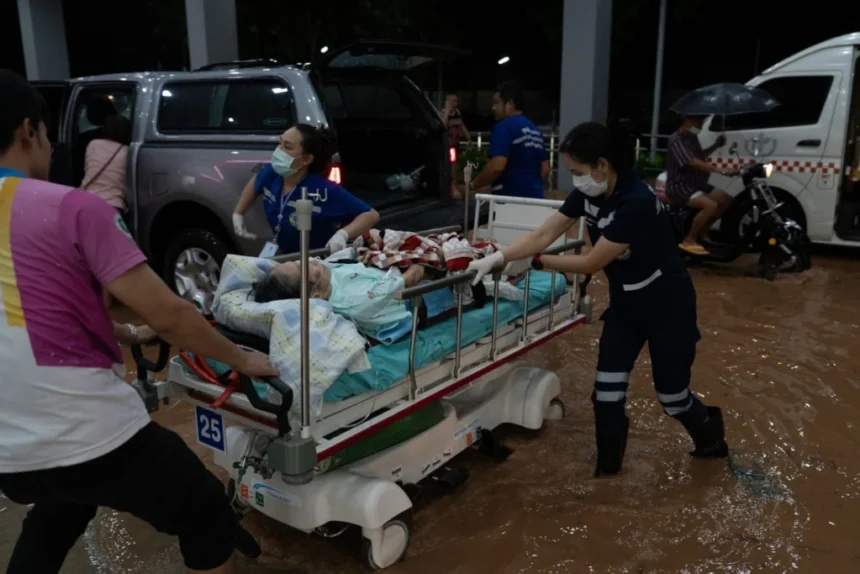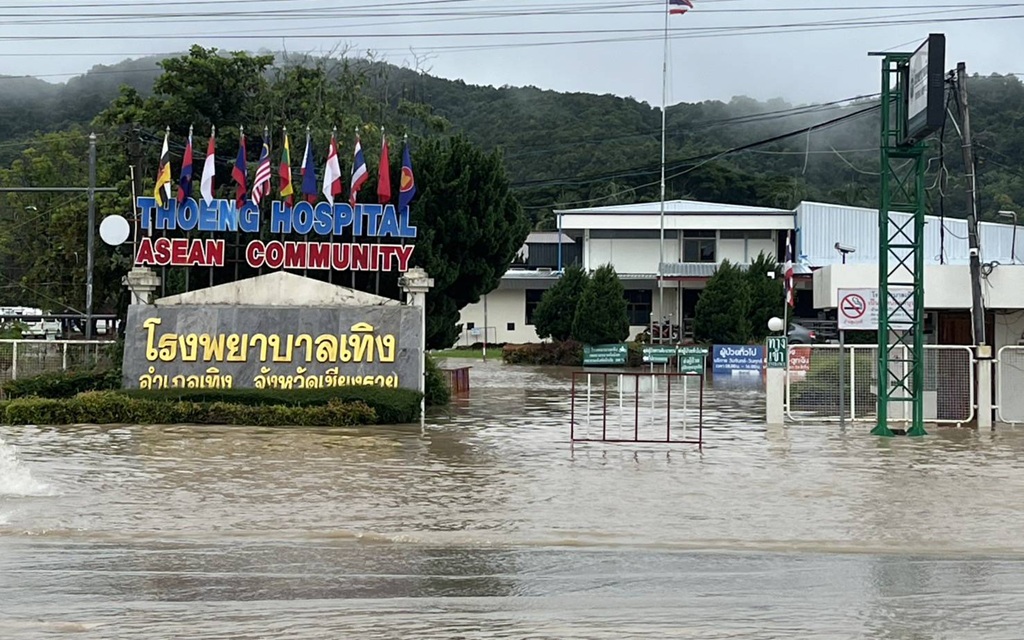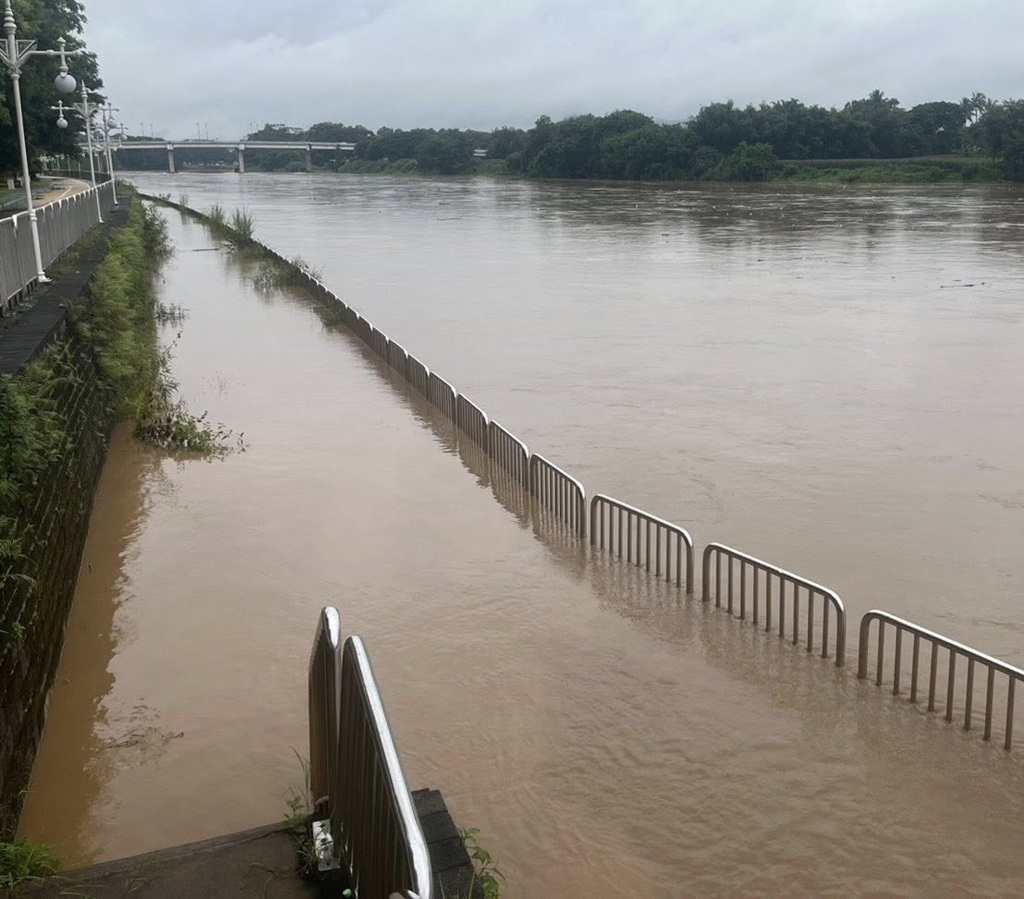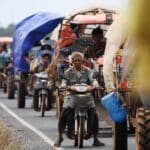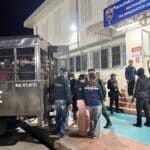CHIANG RAI – Relentless rain from Tropical Storm Wipha has caused major flash floods throughout northern Thailand, sending water pouring into homes, farms and public buildings.
The storm has disrupted life in many provinces and forced hospitals in Nan and Chiang Rai to evacuate emergency patients after floodwaters swamped medical centres, interrupting care for those who need it most.
In Chiang Rai, the Kok River is under constant watch as water keeps rising, raising worries of another disaster like last year’s flooding.
On 23 July, Wiang Sa Hospital in Nan Province had its ground floor submerged as water surged into its emergency department. Staff worked through the flood to move patients, especially the elderly and those in serious condition, up to higher floors or transfer them to safer hospitals.
Dr. Somsak Rattanaporn, a senior doctor at Wiang Sa Hospital, described the scene as hectic but under control. Despite the flood, the hospital has stayed open but only at limited capacity, as medical teams make their way through flooded corridors to help patients.
Thoeng Hospital Flooded
Just a day before, in Chiang Rai’s Thoeng district, Thoeng Hospital was surrounded by water spilling from local reservoirs and runoff from the nearby hills. Medical staff evacuated patients with minor symptoms to a temporary clinic at Ban Pang Kha HPH in Tambon Tab Tao.
Emergency boats were sent in to move urgent cases and staff through the waterlogged streets. Anake Pantayam, Thoeng district chief, worked with police and soldiers to direct the evacuation. Floods also reached the local police station, a school and the courthouse, leaving much of the area paralyzed.
The damage has hit other parts of Chiang Rai as well. In Phaya Mengrai and Wiang Chai districts, floodwaters surged through villages and across farmland. The Tak River broke its banks in Phaya Mengrai, putting Ban Thung Chao village under water and leaving Wat Boonyawat with over a metre of flooding.
Roads Flooded in Chiang Rai
Chusawat Sawatdee, the district chief, reported non-stop efforts by emergency crews and ordered residents in high-risk areas to leave their homes. Wiang Chai saw flash floods rush down from the hills, swamping 15 villages in Tambons Don Sila and Pha Ngam and blocking roads, leaving homes under waist-deep water.
One resident from Yao Mae Tam village said the flooding happened faster than ever before, turning the main road into a stream.
The Kok River, so important to the Chiang Rai area, is now a source of great anxiety. Runoff from Myanmar and heavy rain pushed the river’s flow up to a dangerous 1,000 cubic metres per second on 23 July.
Local authorities keep monitoring it closely, hoping to avoid another situation like 2024, when the Kok River spilled over, shutting down Mae Fah Luang Chiang Rai International Airport and flooding Muang district.
Last year’s severe flooding, which hit after Typhoon Yagi and the shift from El Niño to La Niña, displaced over 133,000 families in 28 provinces, causing an estimated 4 billion baht in damage in Chiang Rai alone.
Kok River Flood Watch
Suttipong Juljarern, the permanent secretary for the Interior Ministry, said teams are doing their best to stop a repeat. Although water in the Sai River (a tributary of the Kok) has eased a little, risks remain high.
The Department of Disaster Prevention and Mitigation (DDPM) has sent relief across the north, working with local teams, the army and volunteers to protect communities and hand out supplies. In Nan, people living close to the Nan River in Tambons Nai Wiang, Du Tai and Kong Khwai in Muang district have been told to move to shelters.
Chiang Rai’s disaster officers have warned all districts to get ready for more flooding, suggesting people raise valuables to safer spots and prepare to leave if needed. The ongoing floods have added to the worries for rural families, whose incomes rely on crops.
In Phaya Mengrai, 500 rai of rice fields are now underwater, threatening both food security and family budgets. Farmers such as Somsri Chaiyaporn saw whole harvests destroyed in a few hours.
The DDPM is now surveying losses and handing out urgent supplies, but the scale of destruction looks set to make recovery a real challenge.
As forecasts show more storms ahead, with thunderstorms predicted to continue through 25 July, northern Thailand stays on alert. Residents and emergency crews keep working hard to keep each other safe.
Yet, as these floods grow more common, there is growing pressure to improve infrastructure and long-term flood prevention. For now, communities across Nan and Chiang Rai face a tough clean-up and the hope that the Kok River does not bring even more trouble.
Related News:
Chiang Rai Posts Red Warning Flags Along the Kok River as Water Levels Increase




